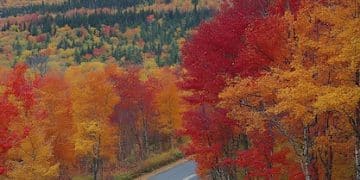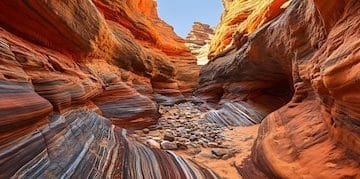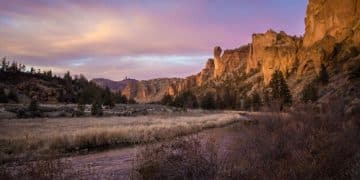Top 5 National Park Road Trips 2025: Maximize Vacation
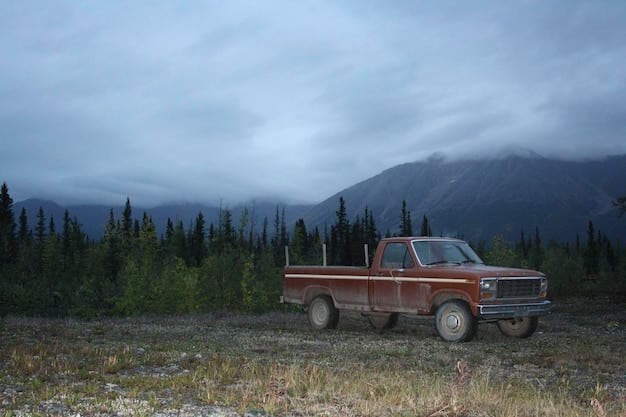
Embark on an unforgettable adventure through America’s natural wonders in 2025 by exploring the top five national park road trip routes, meticulously planned to maximize your vacation days and immerse you in diverse, breathtaking landscapes. These curated itineraries combine iconic parks with hidden gems, offering unparalleled experiences for every traveler.
Are you yearning for an escape, a journey that reconnects you with nature’s grandeur and offers a true respite from the everyday? The anticipation of exploring America’s majestic landscapes is palpable, and for 2025, we’ve meticulously compiled the ultimate guide to Unveiling the Top 5 National Park Road Trip Routes for 2025: Maximize Your Vacation Days. These aren’t just trips; they are curated experiences designed to imprint lasting memories, optimize your time off, and reveal the unparalleled beauty of our national treasures.
The Grand Southwest Loop: A Symphony of Desert and Canyons
The American Southwest stands as an undisputed titan of natural beauty, offering a kaleidoscope of colors, geological formations, and ancient histories. Our first recommended route for 2025, the Grand Southwest Loop, is a testament to this, weaving together some of the most iconic national parks into a journey that is both visually stunning and profoundly spiritual. This comprehensive itinerary is perfect for those with a generous vacation window, typically 10-14 days, allowing ample time to delve into each park’s unique offerings.
Beginning in Las Vegas, a convenient hub for arrivals, this loop typically ventures eastward into Utah, encompassing Zion and Bryce Canyon National Parks, before swinging south to the geological marvels of the Grand Canyon in Arizona. From there, adventurers can head further east to Monument Valley Navajo Tribal Park and then north through Capitol Reef and Arches National Parks, concluding arguably in Denver or returning to Las Vegas. The beauty of a road trip lies in its flexibility, enabling travelers to customize their journey based on interests and available time. Each park on this route presents its own distinct character, from Zion’s towering sandstone cliffs and emerald pools to Bryce Canyon’s otherworldly hoodoos, and the sheer scale of the Grand Canyon.
Exploring Zion and Bryce Canyon: A Tale of Two Parks
Zion National Park captivates visitors with its accessible canyon floor, offering picturesque riverside trails and challenging hikes like Angels Landing for the intrepid. The shuttle system within the main canyon makes navigation easy, allowing you to focus on the breathtaking scenery. Adjacent Bryce Canyon, though smaller, offers a completely different visual feast. Its natural amphitheater, carved over millennia, is filled with thousands of whimsical spire-shaped rock formations called hoodoos.
- Zion’s Riverside Walk: An easy, paved path leading to the Narrows.
- Emerald Pools Trail: A moderate hike with waterfalls and lush vegetation.
- Bryce Amphitheater: Viewpoints like Inspiration Point and Sunset Point offer panoramic vistas.
- Navajo Loop Trail: Descends into the hoodoos, providing an immersive experience.
Preparing for this segment means packing versatile gear. Layers are essential, as desert temperatures can fluctuate dramatically between day and night. Sturdy hiking boots, plenty of water, and sun protection are non-negotiable. Booking accommodations or camping permits well in advance is critical, especially during peak seasons, as these parks are immensely popular. Each park offers unique perspectives and photographic opportunities that change with the light, making early mornings and late afternoons prime times for exploration.
The Grand Canyon’s Majesty and Arches’ Sculpted Wonders
No trip to the Southwest is complete without witnessing the sheer immensity of the Grand Canyon. The South Rim, open year-round, offers the most accessible viewpoints and infrastructure. Hiking below the rim requires significant planning and physical conditioning, but even a short descent provides a profound sense of the canyon’s scale. Eastward, Arches National Park in Utah showcases over 2,000 natural sandstone arches, sculpted by millennia of erosion. Delicate Arch, the state symbol, is a must-see, particularly at sunset.
While the Grand Canyon evokes a sense of timelessness and overwhelming scale, Arches is a testament to nature’s artistry. The contrast between these two monumental landscapes within the same trip is what makes the Grand Southwest Loop so compelling. Consider driving the scenic loop in Arches and undertaking shorter hikes to features like Landscape Arch and Double Arch. Always check park conditions and trail closures before setting out, as environmental factors like heat and flash floods can impact access and safety. This segment of the journey demands flexibility and an appreciation for raw, untamed beauty.
The Grand Southwest Loop is more than just a collection of national parks; it’s an immersive journey through the geological heart of America. From the ancient formations of the Grand Canyon to the vibrant hues of Zion and Bryce, and the sculptural elegance of Arches, this route promises an unforgettable adventure that truly maximizes your vacation days with unparalleled natural splendor. Detailed planning for logistics, especially accommodation and park entry, will ensure a smooth and rewarding experience across these diverse landscapes.
Pacific Northwest Wilderness: Mountains, Coasts, and Rainforests
For those who dream of mist-shrouded coastlines, ancient forests, and formidable volcanic peaks, the Pacific Northwest Wilderness route offers an unparalleled experience in 2025. This itinerary focuses on the unique ecological diversity of Washington and Oregon, highlighting three distinct national parks that showcase everything from rugged ocean shores to glaciated mountains and temperate rainforests. Ideal for a 7-10 day trip, this route promises a refreshing immersion into cooler, greener landscapes, a stark contrast to the desert environments of the Southwest. Your journey might typically begin and end in Seattle, providing convenient access to the region’s natural wonders.
The route typically encompasses Olympic National Park, Mount Rainier National Park, and Crater Lake National Park. Each park offers a different facet of the Pacific Northwest’s natural grandeur, making for a varied and exciting road trip. Olympic National Park, on Washington’s Olympic Peninsula, is a UNESCO World Heritage site and boasts incredible biodiversity ranging from subalpine forests to rugged coastlines and a unique temperate rainforest. Mount Rainier, an active volcano, dominates the skyline with its massive icefields and wildflower meadows. Further south in Oregon, Crater Lake amazes with its deep blue waters and volcanic rim.
Olympic National Park: Rainforests Meet the Ocean
Olympic National Park is a marvel of ecological diversity, allowing visitors to experience three distinct ecosystems within a single park. The Hoh Rain Forest is a quintessential experience, with ancient trees draped in moss and ferns, creating an ethereal atmosphere. Along the coast, beaches like Ruby Beach and Rialto Beach feature dramatic sea stacks and driftwood, offering opportunities for tide-pooling and contemplative walks. The park’s higher elevations, accessible via Hurricane Ridge, provide stunning views of the Olympic Mountains and the Strait of Juan de Fuca.
- Hoh Rain Forest: Walk the Hall of Mosses to experience a primeval forest.
- Ruby Beach: Explore tide pools and admire sea stacks at low tide.
- Hurricane Ridge: Panoramic views and opportunities for snow activities in winter.
- Lake Crescent: A deep, clear lake perfect for kayaking or leisurely drives.
Planning for Olympic National Park involves considering the vastness of its terrain. It’s a park that requires driving between different sections, so allotting sufficient time for travel is key. Weather in the Pacific Northwest can be unpredictable, even in summer, so packing waterproof and warm layers is essential. Booking early for accommodations, especially in coastal towns or park lodges, is highly recommended. The sheer variety here guarantees that every day brings a new and exciting natural encounter, from wildlife viewing to challenging hikes or serene beach strolls.
Mount Rainier and Crater Lake: Volcanic Majesty
Mount Rainier National Park is dominated by its namesake, the most glaciated peak in the contiguous U.S. Popular areas like Paradise and Sunrise offer breathtaking views, extensive trail networks through subalpine meadows bursting with wildflowers (in summer), and opportunities to witness the mountain’s impressive glaciers. In contrast, Crater Lake National Park in southern Oregon cradles the deepest lake in the U.S., formed within the caldera of a collapsed volcano. The lake’s intense blue color, combined with the surrounding rim drive, creates a truly unforgettable landscape. Rim Village offers exceptional viewpoints and a historic lodge.
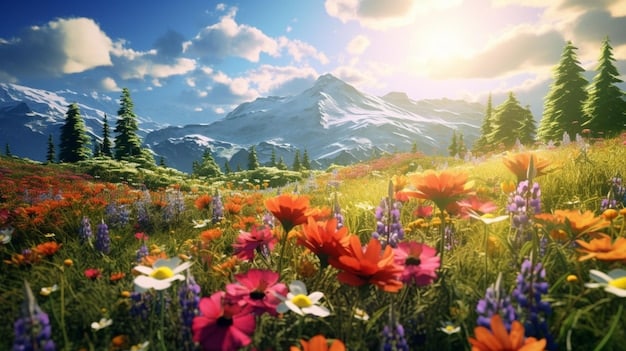
Both parks offer unique perspectives on volcanic landscapes. Mount Rainier showcases the living, breathing power of a volcano, complete with active glaciers and lush vegetation nurtured by its slopes. Crater Lake, on the other hand, is a serene monument to a cataclysmic past, its deep, still waters reflecting the sky. Navigating the scenic roads in both parks is part of the experience, with numerous pull-offs for photo opportunities and short interpretive walks. While Mount Rainier offers more extensive hiking, Crater Lake’s primary draw is its stunning visual appeal and the boat tours that allow closer inspection of Wizard Island. Be aware that parts of the Rim Drive at Crater Lake can be closed due to snow well into the summer, so checking current conditions is vital. These two parks provide a powerful capstone to a journey through the diverse ecosystems of the Pacific Northwest.
This Pacific Northwest adventure combines the raw power of the ocean, the ancient tranquility of rainforests, and the awe-inspiring majesty of volcanic peaks. It is a journey rich in biodiversity and geological wonders, offering a refreshing and invigorating escape for nature lovers seeking cooler climates and lush landscapes. Each national park in this route brings its own distinct charm, creating a cohesive and deeply rewarding travel experience.
Rocky Mountain High: Peaks, Wildlife, and Alpine Beauty
For those captivated by towering peaks, pristine alpine lakes, and abundant wildlife, the Rocky Mountain High route offers an exhilarating national park road trip for 2025. This itinerary, best enjoyed over 7-10 days, typically centers around the majestic landscapes of Colorado and Montana, showcasing the rugged beauty of the American Rockies. This journey is an ode to high-altitude grandeur, offering some of the most dramatic mountain scenery in the country. Starting from a vibrant city like Denver can provide an easy gateway to these elevated adventures.
The core of this route includes Rocky Mountain National Park in Colorado and Yellowstone and Grand Teton National Parks in Wyoming. While Yellowstone and Grand Teton are in Wyoming, their proximity and ecological connection make them a natural extension of any “Rocky Mountain” themed trip. Rocky Mountain National Park, with its Trail Ridge Road, offers unparalleled access to subalpine and alpine environments. Yellowstone is a geothermal wonderland famous for its geysers, hot springs, and abundant wildlife. Grand Teton boasts jagged peaks rising dramatically from Jenny Lake, offering a raw and awe-inspiring landscape.
Rocky Mountain National Park: Above the Treeline
Rocky Mountain National Park is a jewel of the Colorado Rockies, renowned for its diverse ecosystems, from montane forests to alpine tundra. Trail Ridge Road, often called a “highway to the sky,” traverses the park and crosses the Continental Divide, offering spectacular panoramic views. Hiking opportunities abound, with trails ranging from easy strolls around Sprague Lake to strenuous climbs up Longs Peak. Deer, elk, and bighorn sheep are common sightings, particularly during dawn and dusk.
- Trail Ridge Road: Drive America’s highest continuous paved road for stunning views.
- Bear Lake Road Corridor: Access to iconic hikes like Emerald Lake and Cub Lake.
- Many Parks Curve: A scenic overlook offering expansive vistas of the Front Range.
- Wildlife Viewing: Look for elk in Moraine Park and sheep near Sheep Lakes.
Navigating Rocky Mountain National Park requires attention to altitude. Many visitors experience mild altitude sickness, so taking it easy on the first day, staying hydrated, and avoiding strenuous activity can help. Timed entry reservations are often required during peak season, so checking the park’s official website well in advance is crucial. The weather in the mountains can change rapidly, with even summer afternoons bringing thunderstorms and significant temperature drops. Always be prepared with warm layers, rain gear, and plenty of water. The sheer elevation and dramatic landscapes here are truly breathtaking, offering a sense of being on top of the world.
Yellowstone and Grand Teton: Geysers and Glaciers
Venturing north from Colorado, Yellowstone National Park, stretching across Wyoming, Montana, and Idaho, is a bucket-list destination for its unique geothermal features. Old Faithful, Grand Prismatic Spring, and Mammoth Hot Springs are just a few of the many natural wonders. Wildlife, including bison, elk, bears, and wolves, are frequently spotted, making for incredible viewing experiences. South of Yellowstone lies Grand Teton National Park, famed for its dramatic, craggy mountains that rise abruptly from the valley floor, reflecting beautifully in its many lakes like Jenny Lake and Jackson Lake.
These two parks offer a powerful combination of fire and ice: Yellowstone’s geysers and hot springs demonstrate the earth’s fiery core, while Grand Teton’s jagged, often snow-capped peaks embody glacial sculpturing. Wildlife is a major draw in both parks; respecting animal space and speed limits is paramount for safety and animal welfare. Accommodation within these parks books up notoriously fast, often a year in advance, so early planning for lodging or camping is non-negotiable. Exploring both parks over several days allows for a deeper appreciation of their distinct, yet interconnected, ecosystems. From the steaming landscape of Yellowstone to the serene majesty of Grand Teton, this segment of the road trip is guaranteed to inspire awe.
The Rocky Mountain High route is perfect for adventurers seeking to immerse themselves in the raw, untamed beauty of America’s highest ranges. From the alpine tundra of Rocky Mountain to the geothermal wonders of Yellowstone and the stark majesty of Grand Teton, this itinerary promises a diverse and unforgettable journey through some of the nation’s most cherished natural landmarks. Prepare for stunning vistas, incredible wildlife encounters, and the invigorating spirit of the mountains.
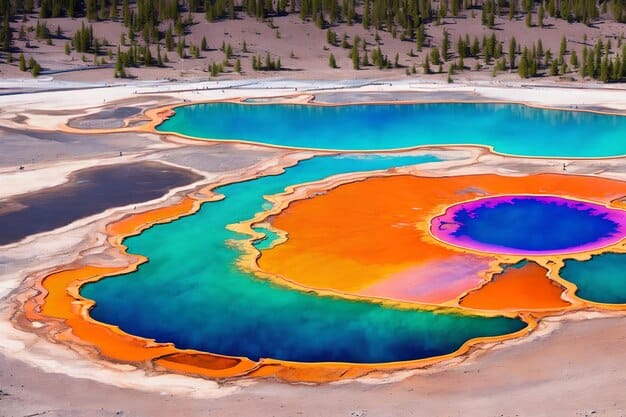
Southeast Wonders: Swamps, Mountains, and Coastal Charm
When considering national park road trips, the Southeastern United States often presents a delightful surprise, offering a distinct blend of natural beauty, rich history, and unique ecosystems not found elsewhere. For 2025, our Southeast Wonders route is designed for travelers seeking diverse landscapes from misty mountains to dense wetlands and charming coastal communities. This itinerary, perfect for a 7-10 day journey, offers a different flavor of American wilderness, where history and nature intertwine seamlessly.
This route typically encompasses Great Smoky Mountains National Park, Everglades National Park, and potentially extending to a scenic drive along part of the Natchez Trace Parkway or visits to historical sites in the region. Starting from a major city like Atlanta or Orlando can offer great access. Great Smoky Mountains National Park, straddling North Carolina and Tennessee, is the most visited national park in the U.S., famous for its ancient mountains, diverse plant and animal life, and remnants of Southern Appalachian mountain culture. Everglades National Park in Florida is a vast wetland ecosystem, a critical habitat for unique wildlife including alligators, panthers, and wading birds. The contrast between these two parks highlights the incredible ecological range of the Southeast.
Great Smoky Mountains: Misty Peaks and Rich Biodiversity
Great Smoky Mountains National Park lives up to its name, with a persistent blue haze often cloaking its forested peaks. This park is renowned for its incredible biodiversity, hosting thousands of species of plants and animals, including one of the most diverse salamander populations in the world. Visitors can enjoy scenic drives like Newfound Gap Road and Cades Cove Loop Road, the latter offering glimpses into historical cabins and abundant wildlife viewing, especially deer and black bears. Extensive hiking trails cater to all levels, from gentle forest walks to challenging ascents along the Appalachian Trail.
- Cades Cove Loop Road: A popular 11-mile scenic drive with historical structures and abundant wildlife.
- Newfound Gap Road: Crosses the park, offering stunning mountain vistas and access to overlooks.
- Gatlinburg and Pigeon Forge: Gateway towns offering amenities and entertainment, though often crowded.
- Clingmans Dome: The highest point in the park, offering panoramic views from an observation tower.
Visiting the Great Smoky Mountains requires a flexible schedule, especially given the park’s popularity. Traffic can be an issue, particularly during peak fall foliage season. Early mornings are best for wildlife viewing and peaceful drives. The weather can also be varied, from warm, humid summers to frosty winters, so packing layers is advisable. The park’s rich cultural history, reflecting the lives of early Appalachian settlers, adds another layer of depth to the natural beauty. Engaging with park rangers on guided walks or at visitor centers can provide invaluable insights into the local flora, fauna, and history.
Everglades National Park: A Subtropical Wetland Haven
Shifting dramatically in landscape, Everglades National Park in southern Florida presents an entirely different yet equally compelling natural spectacle. This vast subtropical wetland is home to an incredible array of marine and terrestrial species. Airboat tours offer an exhilarating way to navigate the “River of Grass” and spot alligators, wading birds, and even the elusive Florida panther. Walking trails, such as the Anhinga Trail, provide close-up views of wildlife in their natural habitat. Flamingo, at the southern tip, offers boat tours into Florida Bay and opportunities for kayaking.
The Everglades is a critical ecosystem, crucial for the survival of many endangered species. Visitors should prepare for hot and humid conditions, especially in summer, and bring plenty of insect repellent. The park has several distinct entrances, each offering different experiences, so planning which areas to visit based on your interests is beneficial. While hiking here is mostly flat and easier, the unique environment requires respect for its delicate balance. From the misty heights of the Appalachians to the whispering sawgrass of the Everglades, this road trip celebrates the unique and often overlooked natural wonders of the American Southeast. It’s a journey that promises both adventure and reflection, immersing travelers in environments unlike any other within the national park system.
The Southeast Wonders route is a testament to the region’s diverse natural heritage. From the ancient, misty peaks of the Great Smoky Mountains to the vibrant, alligator-filled wetlands of the Everglades, this road trip offers an extraordinary journey through varied ecosystems. It’s an ideal choice for those seeking a blend of natural spectacle, abundant wildlife, and a touch of historical charm, all within the warm embrace of the American Southeast.
The Mighty 5 of Utah: A Geologist’s Dream Journey
No discussion of national park road trips would be complete without highlighting Utah’s “Mighty 5,” a collection of five extraordinary national parks that collectively showcase some of the most stunning and diverse red rock landscapes on Earth. For 2025, embarking on the Mighty 5 route is a geologist’s dream and a photographer’s paradise, typically requiring 7-10 days to fully appreciate their unique grandeur. This journey through Southern Utah is an immersive experience in the forces of erosion and time, revealing an unparalleled tapestry of canyons, arches, and natural bridges. Las Vegas or Salt Lake City serve as excellent starting and ending points for this adventure.
The Mighty 5 parks are Zion, Bryce Canyon, Capitol Reef, Arches, and Canyonlands. While Zion and Bryce were touched upon in the Southwest Loop, this route focuses exclusively on Utah, allowing for a deeper exploration of each park. This condensed itinerary provides a rich experience for those specifically drawn to the striking, almost alien landscapes of the Colorado Plateau. Each park, though geographically close, offers a distinct geological narrative and unique recreational opportunities, from river-carved canyons to wind-sculpted formations.
Zion and Bryce Canyon: Iconic and Accessible Wonders
Starting with Zion, its majestic sandstone cliffs and the verdant Virgin River valley offer a dramatic entry into Utah’s park system. Accessible trails like the Pa’rus Trail provide leisurely strolls, while the iconic Angels Landing and The Narrows offer challenging, unforgettable adventures for those seeking more thrill. Bryce Canyon, a relatively short drive from Zion, offers a stark contrast with its amphitheater of vibrant orange and white hoodoos, best viewed from the rim trails or by descending into the canyon itself via routes like the Navajo Loop and Queen’s Garden trail.
- Zion Canyon Scenic Drive: Explore the main canyon via shuttle, accessing popular trailheads.
- Observation Point (East Mesa Trail): Offers a stunning bird’s-eye view of Zion Canyon.
- Sunrise Point (Bryce Canyon): Witness the first light illuminate the hoodoos.
- Fairyland Loop Trail: A more strenuous hike offering solitude and varied hoodoo views.
The proximity of Zion and Bryce Canyon allows for an efficient transition between these two distinct wonders. Early morning starts are highly recommended for both parks to avoid crowds and experience the softer light that enhances their colors. Shuttle systems in Zion (seasonal) and Bryce ease navigation and parking concerns. Both parks are prone to extreme temperatures, so planning visits for spring or fall is ideal, or preparing adequately for summer heat. Hydration is key, and sturdy footwear is a must for navigating the varied terrain, from riverbeds to dusty trails. These initial two parks set a high bar for the geological marvels to come, captivating visitors with their raw beauty.
Capitol Reef, Arches, and Canyonlands: The Heart of the Plateau
Continuing eastward, Capitol Reef National Park, often considered the “hidden gem” of the Mighty 5, offers a unique blend of geological and historical exploration. It’s home to the Waterpocket Fold, a major geological monocline, showcasing colorful canyons, domes, and bridges. Visitors can enjoy scenic drives, fruit picking in historic orchards (seasonal), and hikes to panoramic viewpoints. Further east, Arches National Park, with its distinctive sandstone archways, is a landscape forged by wind and water, culminating in the iconic Delicate Arch. Finally, Canyonlands National Park, the largest of Utah’s parks, offers vast, rugged canyon country, carved by the Colorado and Green Rivers. Its three districts—Island in the Sky, The Needles, and The Maze—each offer distinct backcountry experiences, with Island in the Sky being the most accessible.
Capitol Reef provides a quieter, more intimate encounter with Utah’s geology, often less crowded than its neighbors. The scenic drive and short hikes like Hickman Bridge are rewarding. Arches, meanwhile, thrives on impact, with features like Landscape Arch and Double Arch easily accessible, complementing the more challenging hike to Delicate Arch. Canyonlands, particularly the Island in the Sky district, offers awe-inspiring vistas from Mesa Arch and Grand View Point, overlooking a labyrinth of canyons. The diversity among these three parks is astounding. From the subtle beauty of Capitol Reef to the dramatic formations of Arches and the vast, intricate expanse of Canyonlands, this segment of the road trip is a masterclass in desert geology. Planning for these parks includes ensuring ample fuel and supplies between towns, as amenities within the parks are limited. Reservations for park entry and accommodations are crucial during peak season. This entire route is undeniably a journey through some of Earth’s most spectacularly carved landscapes, making it a top choice for maximizing vacation days in 2025.
The Mighty 5 route is an unparalleled adventure, a deep dive into the geological wonders of Southern Utah. Each park offers a unique and profound connection to the ancient forces that have shaped our planet. From the towering cliffs of Zion to the sculpted hoodoos of Bryce, the hidden beauty of Capitol Reef, the iconic arches of Arches, and the immense canyons of Canyonlands, this road trip is a testament to the enduring power and beauty of the natural world.
New England Explorer: Coastal Beauty and Mountain Charm
For travelers seeking a blend of historic charm, autumnal splendor, and the rugged beauty of both coastlines and mountains, the New England Explorer route offers a delightful alternative for a national park road trip in 2025. This itinerary, perfect for a 7-10 day excursion, focuses on the picturesque landscapes of New England, particularly Maine and New Hampshire, providing a unique east coast perspective on national park adventures. This journey celebrates the distinct character of the region, from its pristine shores to its ancient, rolling mountains. Boston or Portland (Maine) serve as excellent starting points, offering easy access to the region’s natural treasures.
The primary focus of this route is Acadia National Park in Maine, complemented by scenic drives through New Hampshire’s White Mountains, encompassing the White Mountain National Forest and its array of state parks and protected areas. While technically only Acadia is a “national park” on this list, the broader region offers a density of protected natural beauty that rivals some of the West’s larger parks, providing a cohesive and enriching road trip experience. Acadia offers a unique blend of mountains, ocean, and forests, while the White Mountains boast iconic peaks and charming New England towns.
Acadia National Park: Mountains Meeting the Sea
Acadia National Park, located primarily on Mount Desert Island in Maine, presents a breathtaking fusion of granite mountains, evergreen forests, and dramatic rocky coastlines. It is the only national park in the northeastern United States and offers a compact yet incredibly diverse experience. Visitors can drive the scenic Park Loop Road, hike gentle trails to panoramic summits like Cadillac Mountain (the first place in the U.S. to see the sunrise for much of the year), or explore picturesque fishing villages like Bar Harbor. Carriage roads, funded by John D. Rockefeller Jr., provide miles of car-free paths perfect for biking and walking.
- Park Loop Road: A 27-mile scenic drive along rocky coastlines and through forests.
- Cadillac Mountain: Accessible by car, offering incredible sunrise and sunset views.
- Jordan Pond House: Famous for popovers and a serene lake experience.
- Ocean Path: Easy walk offering views of Sand Beach and Thunder Hole.
Visiting Acadia is best in the shoulder seasons of spring and fall to avoid summer crowds and enjoy comfortable temperatures and, in autumn, spectacular fall foliage. Reservations are often required for vehicles to access Cadillac Mountain during peak times. The park offers a rich natural and cultural history, and its blend of ocean and mountain scenery is truly unique among U.S. national parks. Whale watching tours are popular from nearby Bar Harbor, adding another dimension to the coastal experience. The rugged beauty of this park, particularly where the mountains plunge directly into the Atlantic, leaves a lasting impression, showcasing the unique character of New England.
White Mountains: Presidential Peaks and Scenic Drives
While not a national park, New Hampshire’s White Mountains region, anchored by the vast White Mountain National Forest, offers a high-quality “national park” experience with its majestic peaks, extensive trail system, and stunning scenic drives. The Kancamagus Highway is a renowned scenic byway, especially famous for its vibrant fall colors, but beautiful in any season. Major peaks like Mount Washington, the highest point in the Northeast, offer challenging hikes and a unique high-alpine ecosystem, accessible by the historic Mount Washington Cog Railway or the scenic Mount Washington Auto Road. Charming towns like North Conway and Littleton provide hospitality and local flavor.
The White Mountains provide a dramatic inland contrast to Acadia’s coastal charm. Here, the landscape is defined by ancient, deeply forested mountains, carved by glaciers, and dotted with clear rivers and waterfalls. The variety of outdoor activities is immense, from serious mountaineering to family-friendly walks, swimming in natural pools, and even visiting picturesque covered bridges. Fall foliage here is world-famous, painting the landscape in a riot of red, orange, and gold. Planning for the White Mountains involves checking road and trail conditions, especially at higher elevations, as weather systems can be unpredictable. This segment completes the New England Explorer, offering a balanced journey through some of the East Coast’s most beloved natural and cultural landscapes. It’s a trip that delights with both its grandeur and its quaint charm.
The New England Explorer route offers a refreshing departure from the expansive western parks, delivering a unique blend of coastal grandeur and historic mountain charm. From the crashing waves and granite cliffs of Acadia to the rolling, forested peaks of the White Mountains, this trip is ideal for those who appreciate natural beauty intertwined with a rich cultural tapestry. It promises a memorable journey through quintessential New England landscapes, perfect for maximizing your vacation days in 2025.
| Key Point | Brief Description |
|---|---|
| 🏜️ Grand Southwest Loop | Explore iconic parks like Grand Canyon, Zion, and Arches, showcasing desert and canyon wonders. |
| 🌲 Pacific Northwest Wilderness | Discover ancient forests, rugged coasts, and volcanic peaks in Olympic, Rainier, and Crater Lake. |
| 🏔️ Rocky Mountain High | Experience alpine beauty, geysers, and abundant wildlife in Rocky Mountain, Yellowstone, and Grand Teton. |
| 🌅 Mighty 5 of Utah | A focused journey through Utah’s five national parks: Zion, Bryce, Capitol Reef, Arches, and Canyonlands. |
Frequently Asked Questions About National Park Road Trips
The best time varies significantly by region. Spring and fall generally offer the most pleasant weather, fewer crowds, and vibrant natural beauty (wildflowers in spring, foliage in fall). Summer is popular but can be very hot and crowded in desert parks. Winter often brings unique beauty but can lead to road closures in mountainous parks.
For popular parks and during peak seasons, it is highly recommended to book accommodations, including campsites and lodges, 6-12 months in advance. Many park lodges and prime campsites can sell out within minutes of their booking windows opening. Last-minute options are often available further outside the parks.
Essentials include comfortable hiking shoes, layered clothing for varying temperatures, rain gear, plenty of water, snacks, sun protection (hat, sunscreen, sunglasses), a first-aid kit, maps (as cell service can be spotty), and a camera. Headlamps, bug spray, and bear spray (where appropriate) are also advisable.
The “America the Beautiful – The National Parks and Federal Recreational Lands Pass” costs $80 annually and covers entrance fees at all U.S. national parks and federal recreational lands for one vehicle. If your road trip includes three or more parks, it typically pays for itself, offering significant savings and convenience.
Practice Leave No Trace principles: pack out everything you pack in, stay on marked trails, respect wildlife from a distance, travel on durable surfaces, and properly dispose of waste. Conserve water and fuel whenever possible, and choose eco-friendly lodging or camping options.
Conclusion
As we look forward to 2025, the call of the open road and the majesty of America’s national parks beckon with renewed promise. From the fiery red canyons of the Southwest and Utah’s Mighty 5, to the verdant rainforests and snow-capped peaks of the Pacific Northwest, the high alpine lakes of the Rockies, and the unique ecosystems of the Southeast and New England, these five curated national park road trip routes offer unparalleled opportunities to maximize your vacation days. Each journey is designed not just to showcase breathtaking landscapes, but to connect you deeply with the natural world, foster unforgettable memories, and provide a much-needed escape. With careful planning and a spirit of adventure, 2025 can be your year to explore the diverse and awe-inspiring beauty that our national parks lovingly preserve for us all.
